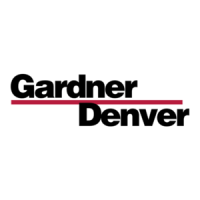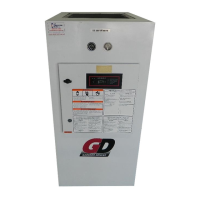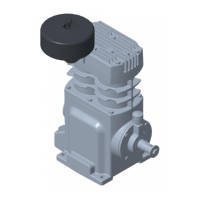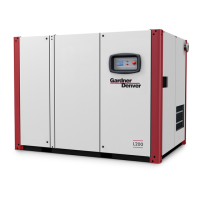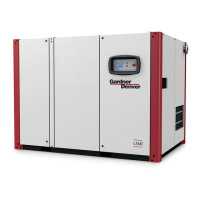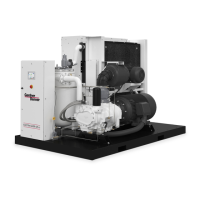Do you have a question about the Gardner Denver INTEGRA EFC99A and is the answer not in the manual?
Crucial safety instructions covering hazards like moving parts, electrical shock, and pressure.
Initial checks, handling, and general placement advice upon receiving the unit.
Safe methods for lifting and transporting the compressor unit to prevent damage.
Recommended environmental conditions and space requirements for optimal compressor placement.
Specific installation details and airflow requirements for air-cooled compressor models.
Guidance on mounting surfaces and foundation considerations for compressor stability.
Instructions for draining oil from the compressor's oil reservoir.
Information regarding the compressor enclosure, access panels, and maintenance space.
Recommendations and precautions for installing and operating the compressor in cold environments.
Detailed precautions for operating units in cold climates, including shelter and heat tape.
Considerations for using an auxiliary air receiver with the compressor system.
Description of the built-in moisture separator and trap system.
Information on factory wiring and piping for the control system.
Guidelines for installing the air inlet line to prevent contamination and ensure proper airflow.
Specifications for pipe size based on the length of the inlet line.
Details on connecting the discharge service line and the function of the air service valve.
Standards and guidelines for electrical wiring, grounding, and qualified personnel.
Requirements for proper equipment grounding according to electrical codes.
Recommendations and procedures for lubricating the drive motor bearings.
Critical checks and servicing required before operating a new compressor unit.
Procedure for verifying correct motor rotation direction to prevent damage.
Guidelines for setting and adjusting system discharge pressure, avoiding overpressure.
Information on selecting and understanding different operating modes for the compressor.
Ensuring the compressor enclosure doors and panels are properly closed and latched.
Step-by-step procedures for starting the compressor in both cold and hot conditions.
Routine daily checks and the correct procedure for stopping the compressor operation.
Introduction to the pre-wired controls, motor, starter, and control box components.
Explanation of the AutoSentry controller's functions and operating modes.
Detailed description of control devices including the AutoSentry controller and relief valve.
Information on the pressure relief valve's purpose, setting, and periodic testing procedures.
How to read the oil level gauge and check the oil status.
Function and operation of the minimum pressure and check valve assembly.
Description of the inlet valve's role in controlling air delivery and compressor unloading.
Function of the solenoid valve in controlling the inlet valve position.
Explanation of the check valve's function and the blowdown valve's role in system pressure release.
Information on system and reservoir pressure transducers and their signals.
Function of the vacuum switch for monitoring air filter condition.
Role of thermistors in monitoring compressor and reservoir temperatures.
Usage of the emergency stop button and function of the control transformer.
Connections for control devices and the function of the main motor starter.
Step-by-step procedure for replacing seals in the minimum pressure/check valve.
Explanation of how oil circulates for cooling, lubrication, and sealing within the compressor.
Guidance on approved lubricants, their properties, and compatibility.
Specific lubricant recommendations for high discharge temperature conditions.
Advice on operating the compressor in cold ambient conditions.
Step-by-step instructions for checking and maintaining the correct oil level.
Guidelines for adding oil between scheduled maintenance intervals.
Intervals for changing compressor lubricant based on discharge temperature.
Procedures for safely draining and cleaning the compressor's oil system.
Instructions on how to properly refill the oil reservoir after draining or maintenance.
Steps involved in upgrading or changing the type of lubricant used in the compressor.
How to read and interpret the oil level gauge on the reservoir.
Causes and effects of moisture contamination in the oil system.
Procedures for replacing the compressor oil filter element and maintenance intervals.
Guidelines for cleaning and maintaining the compressor oil cooler.
Function and maintenance of the thermostatic mixing valve for oil temperature control.
Description of the oil reservoir's multiple functions within the system.
Details on the air/oil separator, its element, and potential carryover issues.
Step-by-step procedure for removing and replacing the oil separator element.
Recommended readings and checks for the compressor oil system at operating temperature.
Checking and monitoring air and oil discharge temperatures for proper operation.
Procedures for checking compressor oil inlet temperature and pressure.
Measuring oil pressure and temperature differentials across the oil cooler.
Description and service instructions for the standard duty air filter.
Guidelines for determining filter element life and replacement criteria.
Steps for removing and installing new drive belts for the compressor.
Procedure for removing and installing compressor sheaves.
Methods for checking belt tension using a spring scale and deflection.
A list of maintenance actions and their recommended frequencies.
Maintenance actions related to the air filter based on operating conditions.
Motor lubrication requirements and intervals as per the maintenance schedule.
Daily checks including oil level, unit loading, pressure, and temperature.
Checks required every 125 hours of operation, focusing on cooler and fan cleanliness.
Maintenance tasks due every 1000 hours, such as oil filter replacement.
Lubricant changes and system flushing required every 4000 hours of operation.
Annual checks including relief valve operation and oil separator replacement.
Troubleshooting steps for a compressor that does not initiate operation.
Diagnosing and resolving issues causing the compressor to stop soon after startup.
Identifying causes and solutions for the compressor not unloading or loading correctly.
Addressing issues causing the compressor to cycle between load and unload states too frequently.
Troubleshooting reasons for the compressor frequently operating in an unloaded state.
Diagnosing causes for slow compressor startup and remedies.
Troubleshooting low compressor output and pressure issues.
Identifying and resolving causes of elevated discharge air temperatures.
Diagnosing and fixing the causes of increased oil consumption in the compressor.
Troubleshooting and resolving problems related to oil carryover into the air lines.
Standard terms, limitations, and exclusions applicable to the product warranty.
Specific warranty durations for different components like airends and motors.
Warranty coverage and conditions specific to the compressor airend assembly.
Warranty terms for key components such as coolers and controllers.
Warranty coverage for the drive and fan motors, including voltage limitations.
Warranty terms for all other components not explicitly listed.
Details on labor coverage, transportation costs, and inspection procedures for warranty claims.
Legal disclaimer excluding implied warranties and limiting company liability.
Crucial safety instructions covering hazards like moving parts, electrical shock, and pressure.
Initial checks, handling, and general placement advice upon receiving the unit.
Safe methods for lifting and transporting the compressor unit to prevent damage.
Recommended environmental conditions and space requirements for optimal compressor placement.
Specific installation details and airflow requirements for air-cooled compressor models.
Guidance on mounting surfaces and foundation considerations for compressor stability.
Instructions for draining oil from the compressor's oil reservoir.
Information regarding the compressor enclosure, access panels, and maintenance space.
Recommendations and precautions for installing and operating the compressor in cold environments.
Detailed precautions for operating units in cold climates, including shelter and heat tape.
Considerations for using an auxiliary air receiver with the compressor system.
Description of the built-in moisture separator and trap system.
Information on factory wiring and piping for the control system.
Guidelines for installing the air inlet line to prevent contamination and ensure proper airflow.
Specifications for pipe size based on the length of the inlet line.
Details on connecting the discharge service line and the function of the air service valve.
Standards and guidelines for electrical wiring, grounding, and qualified personnel.
Requirements for proper equipment grounding according to electrical codes.
Recommendations and procedures for lubricating the drive motor bearings.
Critical checks and servicing required before operating a new compressor unit.
Procedure for verifying correct motor rotation direction to prevent damage.
Guidelines for setting and adjusting system discharge pressure, avoiding overpressure.
Information on selecting and understanding different operating modes for the compressor.
Ensuring the compressor enclosure doors and panels are properly closed and latched.
Step-by-step procedures for starting the compressor in both cold and hot conditions.
Routine daily checks and the correct procedure for stopping the compressor operation.
Introduction to the pre-wired controls, motor, starter, and control box components.
Explanation of the AutoSentry controller's functions and operating modes.
Detailed description of control devices including the AutoSentry controller and relief valve.
Information on the pressure relief valve's purpose, setting, and periodic testing procedures.
How to read the oil level gauge and check the oil status.
Function and operation of the minimum pressure and check valve assembly.
Description of the inlet valve's role in controlling air delivery and compressor unloading.
Function of the solenoid valve in controlling the inlet valve position.
Explanation of the check valve's function and the blowdown valve's role in system pressure release.
Information on system and reservoir pressure transducers and their signals.
Function of the vacuum switch for monitoring air filter condition.
Role of thermistors in monitoring compressor and reservoir temperatures.
Usage of the emergency stop button and function of the control transformer.
Connections for control devices and the function of the main motor starter.
Step-by-step procedure for replacing seals in the minimum pressure/check valve.
Explanation of how oil circulates for cooling, lubrication, and sealing within the compressor.
Guidance on approved lubricants, their properties, and compatibility.
Specific lubricant recommendations for high discharge temperature conditions.
Advice on operating the compressor in cold ambient conditions.
Step-by-step instructions for checking and maintaining the correct oil level.
Guidelines for adding oil between scheduled maintenance intervals.
Intervals for changing compressor lubricant based on discharge temperature.
Procedures for safely draining and cleaning the compressor's oil system.
Instructions on how to properly refill the oil reservoir after draining or maintenance.
Steps involved in upgrading or changing the type of lubricant used in the compressor.
How to read and interpret the oil level gauge on the reservoir.
Causes and effects of moisture contamination in the oil system.
Procedures for replacing the compressor oil filter element and maintenance intervals.
Guidelines for cleaning and maintaining the compressor oil cooler.
Function and maintenance of the thermostatic mixing valve for oil temperature control.
Description of the oil reservoir's multiple functions within the system.
Details on the air/oil separator, its element, and potential carryover issues.
Step-by-step procedure for removing and replacing the oil separator element.
Recommended readings and checks for the compressor oil system at operating temperature.
Checking and monitoring air and oil discharge temperatures for proper operation.
Procedures for checking compressor oil inlet temperature and pressure.
Measuring oil pressure and temperature differentials across the oil cooler.
Description and service instructions for the standard duty air filter.
Guidelines for determining filter element life and replacement criteria.
Steps for removing and installing new drive belts for the compressor.
Procedure for removing and installing compressor sheaves.
Methods for checking belt tension using a spring scale and deflection.
A list of maintenance actions and their recommended frequencies.
Maintenance actions related to the air filter based on operating conditions.
Motor lubrication requirements and intervals as per the maintenance schedule.
Daily checks including oil level, unit loading, pressure, and temperature.
Checks required every 125 hours of operation, focusing on cooler and fan cleanliness.
Maintenance tasks due every 1000 hours, such as oil filter replacement.
Lubricant changes and system flushing required every 4000 hours of operation.
Annual checks including relief valve operation and oil separator replacement.
Troubleshooting steps for a compressor that does not initiate operation.
Diagnosing and resolving issues causing the compressor to stop soon after startup.
Identifying causes and solutions for the compressor not unloading or loading correctly.
Addressing issues causing the compressor to cycle between load and unload states too frequently.
Troubleshooting reasons for the compressor frequently operating in an unloaded state.
Diagnosing causes for slow compressor startup and remedies.
Troubleshooting low compressor output and pressure issues.
Identifying and resolving causes of elevated discharge air temperatures.
Diagnosing and fixing the causes of increased oil consumption in the compressor.
Troubleshooting and resolving problems related to oil carryover into the air lines.
Standard terms, limitations, and exclusions applicable to the product warranty.
Specific warranty durations for different components like airends and motors.
Warranty coverage and conditions specific to the compressor airend assembly.
Warranty terms for key components such as coolers and controllers.
Warranty coverage for the drive and fan motors, including voltage limitations.
Warranty terms for all other components not explicitly listed.
Details on labor coverage, transportation costs, and inspection procedures for warranty claims.
Legal disclaimer excluding implied warranties and limiting company liability.
| Brand | Gardner Denver |
|---|---|
| Model | INTEGRA EFC99A |
| Category | Air Compressor |
| Language | English |
